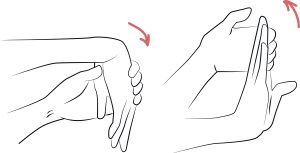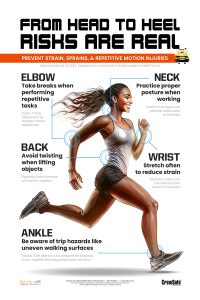You’ve been working for hours without a break, and now you’re starting to feel it, that familiar stiffness creeping into your neck and shoulders. Your wrists ache, your back feels tight, and everything in your body seems to be begging for a little rest. Anyone who stays in the same position for too long, whether sitting or standing, knows this feeling all too well. The same goes for tasks that involve repeating a motion over and over again.
Muscle stiffness, aches, and pains can happen in any job, no matter where you work or what you do. Restaurant workers spend hours on their feet, lifting heavy trays and bending awkwardly. Warehouse workers perform the same motions repeatedly, breaking down boxes and operating equipment. Office workers and assembly workers, on the other hand, spend most of their day sitting, many hunched over, with careful focus. The truth is, it doesn’t matter whether you’re sitting or standing all day, or repeating tasks, without regular stretching and movement, everyone is at risk of injury. The good news? Lowering the risk of long-term pain is simple: just move around and stretch!
Mobility Exercises
Mobility exercises are small movements – like moving and stretching – that keep your muscles active, improve flexibility, and help prevent the soreness and stiffness that build from repeating the same motion, or not moving enough. And the best part is: anyone can improve their flexibility and strength with practice. Many people assume they can’t, but that’s not true. Try this: bend over and touch your toes. If you only try for a few seconds and can’t reach them, it’s not because you’re incapable of it; it’s because your body simply isn’t used to stretching. As science writer Emma Yasinski notes, some people who initially can’t touch their toes are able to do it after just two minutes. “What’s really happening,” she explains, “is that your muscles become more tolerant of stretching.”
Take active breaks and test out these 10 on-the-job mobility exercises to help combat strains, sprains, and repetitive motion injuries (RMIs):
1. Shoulder Rolls
Slowly rotate both shoulders forward in a circular motion 10 times, then reverse and roll them backward 10 times.
When you maintain the same position for long periods such as typing at a desk your shoulder muscles can become tense. This stretch helps relieve tension and improve shoulder mobility.
2. Wrist Extensor Stretch

Sit or stand tall. Extend one arm straight in front of you with the palm facing down. With your other hand, gently pull the fingers of the extended hand downward until you feel a mild stretch along the top of your forearm. Hold for 15 to 30 seconds, then switch sides.
This stretch is helpful for people who perform repetitive wrist movements such as typing or scanning items at a register, as it promotes flexibility and reduces strain.
3. Wrist Flexor Stretch
Begin sitting up straight with your shoulders back. Extend one arm straight in front of you with the palm facing up. Using your opposite hand, gently press the fingers of the extended hand downward until you feel a mild stretch along the underside of your forearm. Hold for 15 to 30 seconds, then switch sides.

This stretch targets the muscles used in gripping and repetitive hand movements, helping to relieve tension and increase wrist flexibility.
4. Neck Side Stretch
Stand or sit up straight with your shoulders relaxed. Gently tilt your head toward your left shoulder, bringing your ear as close to your shoulder as possible without raising the shoulder. Hold this position for a few seconds, then repeat on the right side.
This stretch relieves tension and promotes relaxation in the neck muscles, which can become strained from poor posture or prolonged sitting.
5. Lateral Side Stretch
Stand up straight with your feet a few inches apart. Lift both arms overhead. With your left hand, grasp your right wrist, then lean your upper body gently to the left. Hold for at least 5 seconds, then switch hands and lean to the right. Repeat a few times.
This stretch targets the latissimus dorsi muscles on your back, which can tighten from sitting or standing for long periods. It helps improve flexibility and posture.
6. Chest Opener Stretch
Stand with your back straight and feet shoulder-width apart. Clasp your hands behind your back, straighten your arms, and gently lift your chest upward while squeezing your shoulder blades together. Hold for 10 to 20 seconds, then release.
This stretch helps open the chest and counteracts the rounded shoulder posture caused by long hours of sitting, scanning items, preparing food, or handling cash.
7. Stress Ball
You simply need to squeeze! Nothing more, nothing less.
An article by Traci Pedersen highlights a benefit of a stress ball by saying, “Regular use of stress balls can help strengthen hand and forearm muscles, which may be beneficial for arthritis or as part of physical therapy.”
8. Finger Stretch
Place your hand flat on a table or desk, palm down. Gently spread your fingers apart as wide as possible, hold for 5 seconds, then relax. Repeat 5 to 10 times.
This exercise helps improve finger flexibility, reduce stiffness, and relieve strain from repetitive tasks such as assembly or gripping.
9. Overhead Triceps Stretch
Stand up straight with your chest up. Lift your left arm overhead and bend it behind your head so your hand reaches down between your shoulder blades. Use your right hand to gently press down on your left elbow. Hold this position for at least 10 seconds, then switch arms.
This stretch targets the triceps and shoulders, helping relieve tension and improve flexibility in the upper arms and back of the shoulders.
10. Seated Spinal Twist
Sit upright in a chair with your feet flat on the ground. Place your right hand on the back of the chair and your left hand on your right knee. Gently twist your torso to the right, keeping your spine tall. Hold for 10 seconds, then repeat on the other side.
This stretch releases tension in the lower back and spine, improves mobility, and counteracts stiffness from sitting for extended periods.
Other Tips
While taking short stretch breaks during work can make a big difference, it’s not the only way to prevent future injuries. During breaks, try using that time to move, do a few squats or arm circles, or take a quick walk around the block to keep your body active and your blood flowing. Even just ten minutes of walking can make a noticeable impact.
If you work at a desk or assembly line, consider swapping your chair for a yoga ball. It engages your core muscles and can help reduce strain on your knees and lower back. Another great option is to stand instead of sit when the task allows. If you can complete your work at a higher surface, standing helps keep your joints engaged and reduces stiffness from staying seated too long.
Bottom Line

Mobility exercises are essential in your everyday life and at work, and let’s be honest, most of us forget to do them. Remind your team to stay active at work using CrewSafe’s Off The Wall Employee Safety Awareness training materials, including our November 2025 Strain and Sprain Poster and Lesson Guide. Our Poster & Lesson Guide is in both English and Spanish, and highlights the following injury areas:
- Neck & Shoulder
- Back
- Wrist & Hand
- Elbow
- Ankle & Foot
Setting aside just a few minutes each day to move and stretch can make a big difference in how you feel and help prevent future injuries—though you should always consult a healthcare professional before starting any new exercise routine, as this content is for informational purposes only and not a substitute for personalized medical advice.
Use your breaks wisely: get up, move around, and get that blood flowing!
Sources
- Pedersen, Traci (2023). Do Stress Balls Work? Stress Balls: Effectiveness, Benefits, and Limits
- Yaninski, Emma (2024). What Happens to Your Body If You Don’t Stretch. What Happens to Your Body If You Don’t Stretch | TIME







